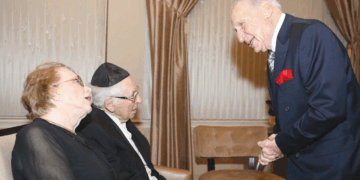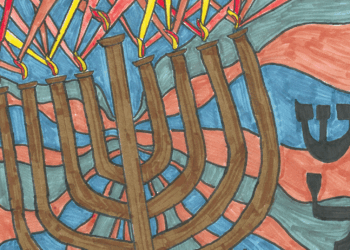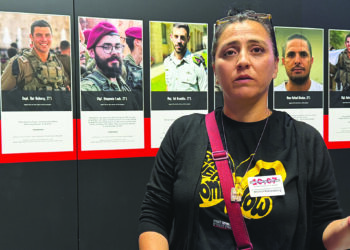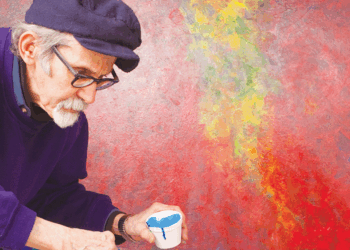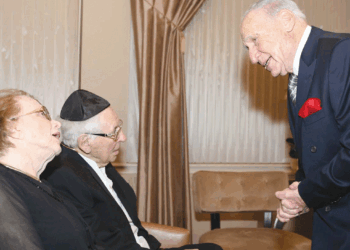Reviewed by NEAL GENDLER
By the time the Soviet army reaches Dörnhau — death’s waiting house — prisoner 33031 has survived starvation, edema and diarrhea only to get typhus.
Dörnhau is a “hospital camp,” both labor camp and depository for prisoners too ill or used up to work. Number 33031 — once journalist József Debreczeni — is in Block A, the broken-windows first floor of a former factory in German Silesia. Six hundred men, most of them naked, lie two and three to a wood-chip bunk.
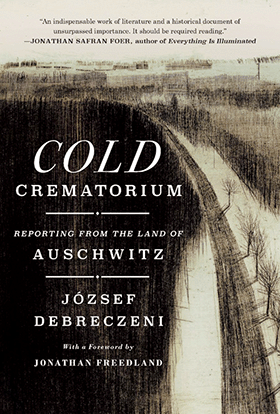 Each day, about 200 die, replaced by new shipments of the helpless.
Each day, about 200 die, replaced by new shipments of the helpless.
József calls it a cold crematorium.
“What readers might well remember most vividly from this book is its unflinching account of the sheer repulsiveness of camp life,” says Jonathan Freedland in his introduction. “None of this is for the squeamish.” Indeed. In this first-person account, József says that many Block A prisoners are too weak to walk to a latrine, urinating and defecating in their bunks or into growing mounds between the bunk rows.
József wrote of descent to this warehouse of the living dead in his native Hungarian. Published in Yugoslavia in 1950, Cold Crematorium disappeared in the Cold War. Out later this month in a fluid translation by Paul Olchváry, it is as factual as a newspaper report, without overt attempts to play on readers’ emotions. That’s its power.
“Debreczeni delivers something of singular value,” Freedland says. “It’s not only that his are the recollections of a fully conscious adult,” not memories from a childhood, “but that he writes as a professional, highly skilled observer…with a journalist’s eye for the telling, human detail.”
József barely mentions four labor camps preceding shipment to Auschwitz with neighbors from a Hungarian area of Serbia in May 1944.
At Auschwitz, prisoners led to a bathhouse “strip buck naked in the biting wind, … commanded to remove the last memory of home: the clothes on our bodies.” The death camp deprives millions “of their individuality, their names, their humanity. How can I someday prove so far from home that I was called this, not that?”
Head and body hair clipped off, he’s marched to a scalding mass shower, then through a gauntlet of striped clothing thrown at him. It’s “slave making on a conveyor belt.”
His group is packed into rail cars headed to Mülhausen, where he gets a new identity: “I’m no longer me, but 33031.”
Exhausted and hungry, feet bleeding in wooden sandals, they’re marched uphill 12.5 miles to a camp being built at Eule, a Silesian town with coal mines and quarries.
At Eule, the Lagerälteste (head prisoner) is French Jew Max, “the all-powerful lord of the camp. A malicious, mercilessness, mercurial lord” whose cane “is just as fearsome as the whip and the revolver of the SS sergeant who is the camp commandant.”
For a couple of marks each, companies lease SS prisoners to build fortifications and prisoner barracks, lay rail lines, mine coal and dig tunnels. József tells us company names. Mining and tunneling are the most miserable, deadly work.
He says calories just sufficient to sustain workers don’t reach them. Food is stolen by kapos — prisoners given power over others. Hatred of kapos is well known; József gives the reasons and hierarchy in unusual detail. They lord it over underlings, brutal for enjoyment or in fear of SS beatings.
“The best slave driver is a slave accorded a privileged position,” he says. These came from “the bottom rungs of Jewish humanity.”
József carries and lays heavy rails from 5 a.m. to 6 p.m. with a half-hour noon break.
One evening, after a two-hour roll call, he’s in a two-day march to camp Fürstenberg III, where conditions are worse. József works building caverns: “backbreaking, soul-crushing labor. The blasting, drilling and carrying out of rocks unfolds incessantly, 24 hours straight in two shifts. … Twenty to 30 [of society’s] outcasts a day drop dead while the enterprise pursues profit.” Some throw themselves beneath trucks for suicide.
A swollen leg gets József transferred to rebuilding the nearby castle. Dysentery returns, his entire body swells. In desperation, he volunteers for a transport of 400, expecting death at Birkenau.
But it’s Dörnhau, where “the Grim Reaper has established an experimental laboratory” in Block A. József calls it “death by contagion: You die because you’ve seen your neighbor’s death throes from start to finish. What’s left of your own life force is infected.”
József develops diarrhea, saying it’s 95 percent fatal. Too weak to sit up, he’s not fed. Lucid moments are fewer. A privileged prisoner who’d been delighted to find a fellow journalist is alerted and provides reviving deliveries of horse liver and horse fat, but József guesses he’s shrunk below 80 pounds.
The first day of spring, he hears artillery, but the Soviet army delays. Typhus begins claiming 40 to 50 a day. József’s vision distorts, his temperature passes 104. He feels “awestruck to realize that although I’m dying, for me it isn’t even so hard. There are more painful ways to go.”
Early on May 5, prisoners discover that the SS guards and the worst kapos have fled.
Two days later, Soviet nurses arrive. Eventually, we get this unique, fascinating book.
***
Neal Gendler is a Minneapolis writer and editor.
(American Jewish World, January 2024)

